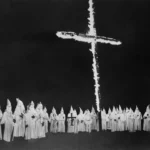The Murder that Ignited a Movement
The year was 1955. The American South simmered under Jim Crow laws, a system designed to oppress and segregate Black people. It was against this backdrop of racial tension that 14-year-old Emmett Till, a Black teenager from Chicago, traveled to Money, Mississippi, to visit relatives. What should have been a summer vacation turned into a tragedy that would expose the nation’s deeply rooted racism and ignite a movement.
Emmett’s alleged crime? A whistle, maybe a glance, directed towards a white woman named Carolyn Bryant while in a store owned by her family. This seemingly insignificant act had deadly consequences. Days later, Carolyn’s husband, Roy Bryant, and his half-brother, J.W. Milam, abducted Emmett from his uncle’s home in the dead of night.
The details of what happened next are horrifying. Emmett was brutally beaten and tortured before being shot and dumped in the Tallahatchie River, a heavy cotton gin fan tied to his neck to weigh down his body.
The Open Casket: A Mother’s Courage, A Nation’s Shame
When Emmett’s body was recovered, his face was so disfigured he was nearly unrecognizable. His mother, Mamie Till Mobley, was faced with an agonizing decision. Some advised a closed casket, but Mamie chose a different path, one of unimaginable strength and heartbreaking purpose. She insisted on an open casket funeral, famously stating, “Let the world see what they did to my boy.”
Mamie Till Mobley’s decision was a pivotal moment in the Civil Rights Movement. Photographs of Emmett in his casket, published in Jet magazine, a prominent Black publication, exposed the horrific reality of racial violence to a nation largely desensitized to the plight of Black Americans. The images became impossible to ignore, sparking outrage and grief across the country.
The Trial and the Photo’s Impact: A Turning Point
The trial of Roy Bryant and J.W. Milam became a chilling spectacle of injustice. Despite overwhelming evidence against them, an all-white jury acquitted the two men after a mere hour of deliberation. The verdict sent shockwaves through the nation and ignited a firestorm of outrage.
The publication of Emmett Till’s funeral photos in Jet magazine served as a catalyst for the burgeoning Civil Rights Movement. While accounts of racial violence were often buried or dismissed, the graphic images of Emmett’s mutilated body offered irrefutable evidence of the hatred and brutality that Black Americans faced. The photos galvanized activists, fueling their fight for justice and equality.
The Legacy of Emmett Till: How His Story Still Resonates Today
Emmett Till’s murder wasn’t just a tragedy; it was a turning point in American history. The boy from Chicago, whose life was cut tragically short, became an unintentional martyr for the Civil Rights Movement.
The image of Emmett in his casket, a stark reminder of the human cost of hate and prejudice, continues to resonate today. His story serves as a powerful reminder that the fight for justice and equality is far from over.
If you’ve ever pondered about voter fraud in historical US elections, you’ll be curious to learn about the voter fraud incident connected to the statehood of Kansas.
- Unlock Elemental 2 Secrets: Actionable Insights Now - April 2, 2025
- Lot’s Wife’s Name: Unveiling the Mystery of Sodom’s Fall - April 2, 2025
- Photocell Sensors: A Complete Guide for Selection and Implementation - April 2, 2025

















2 thoughts on “Emmett Till’s Death and the Photo that Changed America”
Comments are closed.